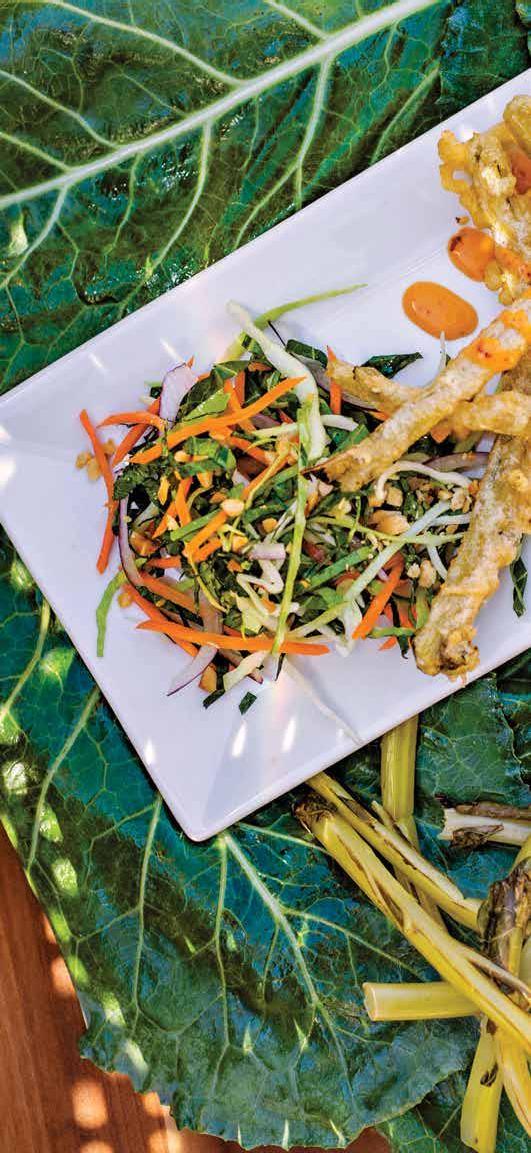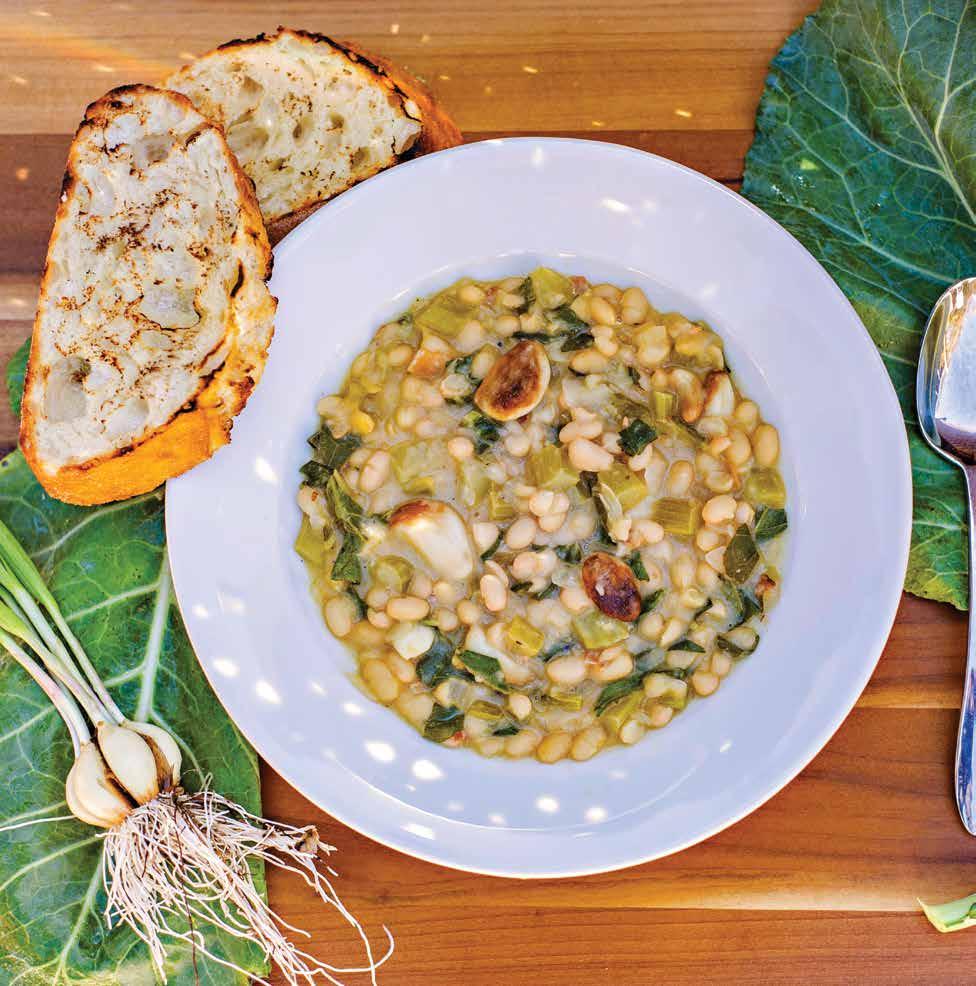
5 minute read
MEAN GREENS
Greens Mean
Collards are surprisingly versatile greens. Here are some inspired alternatives to preparing this southern staple.
Advertisement
STYLED BY CHEF DAN LEWIS PHOTOS BY BROOKE MAYO
ANY SOUTHERNER WORTH THEIR SALT CAN ATTEST TO THE COMFORT FOUND IN A SIMMERING POT OF COLLARD GREENS – it’s a dietary staple in many southern states, but North Carolina in particular has elevated collard production (and consumption) to an art form.
Along with peanuts and sweet potatoes, North Carolina is one of the nations’ top collard producers, earning Eastern North Carolina the distinction of being informally known as the “collard belt” of the country – and the crop’s heartiness is undoubtedly part of its appeal. Typically a cool-season plant that’s grown in a variety of soils, collards can withstand a wide range of temperatures and are often eaten year round – though many believe that the leaves retain their best flavor when they’re picked just after a light frost.
Collards are also simply packed with nutritional value. A one-cup serving of these greens contains a tremendous number of antioxidants, including 771 micrograms of vitamin A and nearly 35 milligrams of vitamin C, plus a significant amount of fiber, calcium and iron – all of which may or may not contribute to its rumored powers as an aphrodisiac.
But those who only associate collards with Southern comfort, may have to think again. The domesticated collard plant actually originated in the eastern Mediterranean before spreading to Europe, where it quickly became a food staple. It’s also the oldest known green in the cabbage family, with ample evidence that it was grown by the ancient Greeks and Romans.
Others who think of collards as a singular type of plant readily available in their local grocery stores, might also be surprised to learn that there are many different varieties of collards – some of
Greens Mean

Collards take the place of cabbage with these shrimp-stuffed collard rolls – including a filling of Carolina Gold rice with finely chopped shrimp and collard leaves. Rolls are served with tomato fennel coulis and grilled baby corn.



which have uniquely evocative names like Ellen Felton Dark, Morris Heading and Old Timey Blue.
Most of today’s known collard varieties are rare heirloom types that have been passed down generationally within families, while others are hybrids that have been bred for disease resistance and high yields. In the early 2000s, two geography professors at Emory & Henry College undertook a project that led them to collect more than 100 collard varieties in a number of southern states as far north as Virginia, and as far west as Arkansas and Louisiana – a collection that was later donated to the U.S. Department of Agriculture’s official seed bank as part of a broader government initiative to protect the genetic diversity of agriculturally important plants.
But when it comes right down to it, collards themselves really aren’t very fussy – and the most traditional way of serving up any variety Southern-style only requires a large pot on a low boil, a bit of bacon and a generous helping of salt and vinegar to top things off. Legend has it that this recipe helped many Southerners survive the Great Depression during the 1930s, and, when served with black-eyed peas on New Year’s Day, they’re still said to represent a prosperous future.
Which doesn’t mean that collards can’t be elevated according to culinary standards. Since they’re ultimately just a green, going beyond tradition only means considering cooking principals with similar vegetables, such as cabbage, lettuce or kale. All that’s required is a willingness to turn over a new leaf.
SEAFOOD • RIBS • CHICKEN
Fresh Produce From Our Secret Garden
Open Monday - Saturday • 5:00 p.m.-until • Closed Sundays
Milepost 9 Bypass, Kill Devil Hills, NC • 252-441-9555 • jksrestaurant.com
Tropical Taste.Casual Place.
LUNCH & DINNER HAPPY HOUR LATE NIGHT FUN FRESH LOCAL SEAFOOD BEER & SIGNATURE COCKTAILS STEAM BAR
Goombays Grille & Raw Bar | Milepost 7 on the Beach Road
Greens Mean
Though normally made with Tuscan kale, this Tuscaninspired white bean soup substitutes collards for an earthy Eastern Carolina richness, along with bacon, onion, celery and cloves of roasted garlic.

Tuscan White Bean Soup with Collards

Servings: about six cups
8 oz dried white beans (such as navy) 1/2 cup diced bacon or pancetta 1 small onion, diced 2 stalks celery, diced 1 tablespoon garlic, minced 2 quarts chicken broth 3 bay leaves 1 sprig each fresh rosemary, thyme and sage 1/2 cup garlic cloves 1 tablespoon olive oil 1-2 cups chopped collards Salt and pepper to taste
Soak the beans overnight in water, then drain. Render bacon or pancetta on medium-low heat in a soup pot until almost crisp. Add onion, celery and minced garlic, then cook together for about 5 minutes. Add beans, broth and herbs, and let everything simmer for several hours until the beans are tender.
While the beans are cooking, combine garlic cloves with olive oil and roast them in the oven at 350° until nicely browned – approximately 20-30 minutes. Add collards and the roasted garlic cloves to the other ingredients for the last hour of cooking, then season all with salt and pepper to taste. (Optional: Can omit bacon or pancetta and use vegetable broth to make a vegan version.)
MP 9
Beach Rd.
Kill devil hills


FOLLOW THE SUN ALL YEAR!
SPRING 2021
VOLUME 135
THE JOY OF BREADMAKING
THE CRAFTSMANSHIP OF WOODS ROAD FURNITURE
FREE!
FALL/WINTER 2020 ISSUE NO. 134
OUTER BANKS
A PIECE
OF
Free!
Summer 2021 • Volume 136
THE MARC BASNIGHT BRIDGE / JOCKEY’S RIDGE / CAPE HATTERAS LIGHTHOUSE LIKE YOU’VE NEVER SEEN THEM BEFORE! ARTISTS CAPTURE OUTER BANKS ARCHITECTURE FREE! Splash Col Rodanthe’s Randi O’Sullivanbrightens the art world TIME TIMEAFTER CapTuring The Beach Then & noW
VOLUME 137 • FALL 2021 FrEE! OUT OF THIS WORLD (CLAM CHOWDER, THAT IS) OUTER BANKS! NEW ENGLAND HATTERAS VS.
CapTuring The Beach Then & NoW









